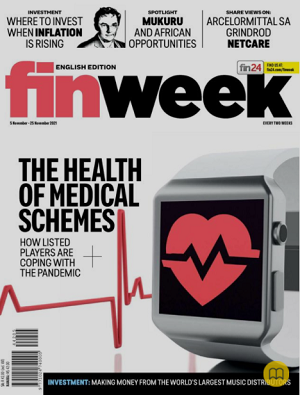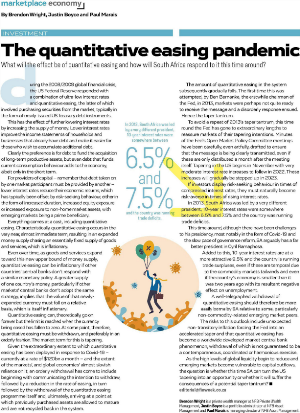The Quantitative Easing Pandemic
What will the effect be of quantitative easing and how will South Africa respond to it this time?


During the 2008/09 Global Financial Crisis, the US Federal Reserve responded with a combination of ultra-low interest rates and quantitative easing, the latter of which involved purchasing securities from the market, typically in the form of newly issued US Treasury debt instruments.
This has the effect of further lowering interest rates by increasing the supply of money. Lower interest rates improve the income statements of households and businesses that already have debt and makes it easier for those who wish to accumulate additional debt.
Clearly the preference is for debt to fund the acquisition of long-term productive assets, but even debt that funds current consumption behaviour adds to the economy, albeit only in the short-term.
For providers of capital – remember that debt taken on by one market participant must be provided by another - lower interest rates reduce their economic returns, which has typically been offset by risk-seeking behaviour, either in the form of increased duration, increased equity exposure or increased exposure to non-home market assets with emerging markets being a prime beneficiary.
Everything comes at a cost, including quantitative easing. Characteristically, quantitative easing occurs in the very near, almost immediate term, resulting in an expanded money supply chasing an essentially fixed supply of goods and services which is inflationary.
Even over time, as goods and services expand toward this new upper bound of money supply, quantitative easing can be inflationary if other countries’ central banks don’t respond with a similar monetary policy. A greater supply of one country’s money, particularly if other markets central banks don’t adopt the same strategy, implies that the value of that newly expanded currency must fall on a relative basis, which is itself inflationary.
Quantitative easing can, theoretically, go on forever but the limit is reached when the currency being eased has fallen to zero. At some point, therefore, quantitative easing must be withdrawn, and preferably in an orderly fashion. The market term for this is tapering.
Given the extraordinary extent to which quantitative easing has been deployed in response to Covid - currently at a rate of $120 billion a month - and the extent of the markets’, and global economies’ almost slavish reliance on it, an orderly withdrawal has come to include beginning with communicating the intention to withdraw, followed by a reduction in the rate of easing, in turn followed by the withdrawal of the quantitative easing programme itself and, ultimately, arriving at a point at which previously purchased assets are allowed to mature and are not recycled back in the system.
The amount of quantitative easing in the system subsequently gradually falls. The first time this was attempted, by Ben Bernanke, the erstwhile Federal Reserve Governor, in 2013, markets were perhaps not quite ready to receive the message and a disorderly response ensued. Hence the Taper Tantrum.
To avoid a repeat of 2013’s Taper Tantrum, this time round the US Federal Reserve has gone to extraordinary lengths to reassure markets of their tapering intentions. Minutes of the Fed’s Open Market Policy Committee meetings have been carefully, even artfully, drafted to ensure that the message is being clearly transmitted, even if these are only distributed a month after the meeting itself. Tapering in the US begins in November with very moderate interest rate increases to follow in 2022. These increases will gradually be stepped up in 2023.
If investors display risk-seeking behaviour in times of compressed interest rates, they must naturally become risk-averse in times of rising interest rates.
In 2013, South Africa was led by a very different president, 10-year interest rates were somewhere between 6.5% and 7.5% and the country was running trade deficits.
This time around, although there have been challenges to his presidency, most notably in the form of Covid and the slow pace of governance reform, South Africa arguably has a far better president in Cyril Ramaphosa.
Added to this, 10-year interest rates are at a more attractive 9.5% and the country is running trade surpluses, even if these are temporal due to the commodity markets tailwinds and even if the country’s economy is smaller than it was two years ago with its resultant negative effect on unemployment.
A well-telegraphed withdrawal of quantitative easing should therefore be more easily borne by South Africa relative to some, particularly non-commodity related emerging market peers.
The risks to this outlook include unexpected non-transitory inflation forcing the US Federal Reserve into an accelerated taper and that quantitative easing has become a worldwide developed market central bank phenomenon, withdrawal of which is not guaranteed to be a contemporaneous, co-ordinated or harmonious exercise.
As the high levels of global liquidity begin to reduce and emerging markets become vulnerable to capital outflows, the question is whether this time South Africa can turn the US tapering into an opportunity or whether it will suffer the consequences of a potential taper tantrum?
|
This article, "The quantitative easing Pandemic " was written exclusively for Finweek Magazine. It was published in the Finweek edition on page 26. You can access the original print coverage in English here. |
||
 |
 |
|













